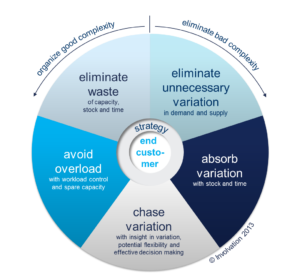This is Demand Driven SCM – Part 4

Part Three of this four-parter clarified exactly what DDSCM is and why you should want it. The only question that now remains is how DDSCM can help you in practice.
DDSCM’s Wheel of 5
To help you devise your own DDSCM improvement strategies and solutions, we have developed the 5 Principles of DDSCM. These five principles are based on the fundamental laws of supply chain physics (Hopp and Spearman, 2000), containing five complementary guidelines and/or design principles.
- Eliminate unnecessary variation in supply and demand
- Absorb unpredictable variation with stock and time
- Chase predictable variation with potential flexibility and effective decision-making
- Avoid overload by controlling the workload and keeping spare capacity at strategic locations
- Eliminate waste of capacity, stock and time
 Together, these five guidelines are aimed at reducing response times while also eliminating unnecessary variation and uncertainty in order to escape the planning mismatch. On the one hand, the principles are designed to inspire you to devise your own demand-driven improvement strategies and solutions, and on the other you can use them to check whether your improvement measures will actually help you to escape the planning mismatch.
Together, these five guidelines are aimed at reducing response times while also eliminating unnecessary variation and uncertainty in order to escape the planning mismatch. On the one hand, the principles are designed to inspire you to devise your own demand-driven improvement strategies and solutions, and on the other you can use them to check whether your improvement measures will actually help you to escape the planning mismatch.
By the way, when applying the five principles it is also essential to differentiate between ‘necessary’ and ‘unnecessary’, or ‘good’ and ‘bad’. To make this differentiation, you should consider what your end customer needs and when. ‘Necessary’ and ‘good’ are variation and buffers that make a positive contribution to that. Anything that does not should be classified as ‘unnecessary’, ‘bad’ and ‘waste’.
DDSCM is on the cusp of a breakthrough
Thankfully, we are gradually seeing more and more companies that are no longer willing to accept their dependence on unreliable forecasts and plans. Having realized the limitations of forecasts and plans, especially when it comes to predicting future details, they have opted for some form of DDSCM. The results have been amazing for all of them: better and cheaper with less hassle! In addition to international cases such as Zara and Apple, companies closer to home such as Auping, Enexis, Shell, Stedin and Liander have all enjoyed success (see box).
The growing awareness of DDSCM is also increasing the focus on demand-driven planning concepts, ranging from repetitive flexible scheduling to scrum and from Drum Buffer Rope to POLCA. Perhaps the most notable approach is DDMRP, which has even been embraced by SAP recently. Although they are all slightly different because they have been developed for use in different situations, what they all have in common is that they are in some way based on demand-driven principles.
Over the coming decade, the number of companies actively attempting to escape the planning mismatch – whether they call it DDSCM or not – will undoubtedly skyrocket. Of course, it is entirely up to you to decide whether you want to be part of that. But if you decide not to opt for DDSCM, you should realize that you will remain at the mercy of the planning mismatch, placing your performance in the hands of unreliable forecasts and plans. So brace yourself!
This brings us to the end of our four-parter on Demand Driven Supply Chain Management. If you would like to know more, feel free to contact Alex Tjalsma: a.tjalsma@involvation.com


